The Ford Escape is a very popular little crossover SUV – but what if you’d like it with more engine – or a plug?
And AWD?
Maybe a 14 speaker Revel ultra-premium audio rig, too?
Head on over to a Lincoln store.
There you’ll find the Corsair – which is based on the Escape but more than a Ford. It offers a stronger version of the Escape’s strongest optional engine – and the option to roll faster without any engine at all for about 28 miles or so, depending on how you roll.
What It Is
The Corsair is the smallest crossover Lincoln sells. It is also the most affordable, with its base price of $35,945 being just slightly higher than the price of a loaded Ford Escape, which stickers for $33,300 – and which you cannot buy with the 295 horsepower 2.3 liter turbocharged engine that’s available in its Lincoln-suited brother.
A plug-in hybrid version of the Corsair is also now available.
It stickers for $50,230.
Ford also sells a plug-in version of the Escape, but with less engine – and without AWD.
It does, however, offer more range – up to 37 miles.
What’s New
The Grand Touring plug-in hybrid version – which packs 268 horsepower, a 14.4 kilowatt-hour lithium-ion battery pack and three electric motors- is the main addition to the Corsair’s options list for the 2021 model year. 
A monochromatic appearance package is also available.
It includes a special 20-inch wheel/tire package, another not-available-with-Escape enticement to go Lincoln rather than Ford.
What’s Good
A posher, more powerful Escape.
Electric operation – without the electric wait.
Extremely competitive price vs. similar compact-sized crossovers like the BMW X3 ($48,895 to start) and Mercedes-Benz GLC ($47,910 to start).
What’s Not So Good
A bit less backseat leg/head and cargo room than in the Escape.
Costs a lot to drive without using any gas.
Stop-start “technology” (non-hybrid versions) is difficult to turn off.
Under The Hood
The Corsair comes standard with one more cylinder – and lot more power – than what comes standard in an Escape. The latter is equipped with a 1.5 liter three cylinder engine that manages (remarkably, given how small it is) to gin up 181 horsepower through the miracle of pressurization, i.e., via turbocharging it.
Still, it’s not much engine – even for a small crossover.
The base trim Corsair comes standard with a more size-appropriate 2.0 liter, much stronger 250 horsepower engine – also turbocharged – that is the same engine as the Escape’s strongest available engine. It is paired with an eight-speed automatic – not a CVT – and either front-wheel-drive or (optionally) all-wheel-drive.
Lincoln gives you another option, too. One that is not available with the Escape.
You can upgrade to a 295 horsepower 2.3 liter engine – also turbo’d. This engine is available in all trims, too.
It is paired exclusively with AWD – to spread out the power over four rather than just two wheels – and gets the Corsair to 60 in just over six seconds, a more-than-fractional difference vs. the Escape equipped with its strongest (2.0 liter) engine, which takes about 7.7 seconds to make the same run.
You can’t just a la carte the 2.3 liter engine. It is only available as part of an options package that boosts this little crossover’s MSRP by several thousand bucks – but you also get amenities such as heated rear seats, a heated steering wheel, rain-sensing wipers and Lincoln’s “CoPilot” 360 suite of driver “assistance” tech as part of the deal.
If you want to burn less rubber – or rather, gas – there is a brand-new hybrid drivetrain option, which also comes standard with a plug.
This means you can recharge the batteries without running the engine. But it also means you don’t have to stop driving to plug in when you use up the hybrid’s roughly 28 mile range on battery power. The gas engine will come on to keep you moving and recharge the batteries as you drive.
You can plug in at home – or work. But you don’t have to.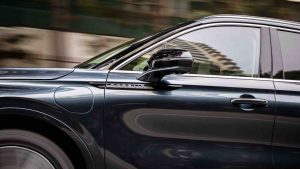
That’s the big everyday advantage of the plug-in hybrid layout. There’s no range anxiety – and there’s no mandatory waiting. The big disadvantage is the cost, which you may never make up in gas savings.
This hybrid is also strong, which helps to offset the cost.
It has the largest gas engine (2.5 liters) available in a Corsair, paired with three electric motors – one of which summons up a mighty 110 ft.-lbs. of torque all by itself. This one drives the rear wheels while the other two power the front wheels, with the power split determined according to wheel-slip, as is usually the case in all-wheel-drive-equipped vehicles.
Curiously, the plug-in version of the Escape is front-drive only.
It is also less powerful, packing 221 horses (combined output) while the Corsair offers up 268 horses. This is sufficient to make the hybrid Corsair about as quick by the numbers as a non-hybrid (250 horsepower) Corsair while also averaging about 33 MPG vs. the non-hybrid 2.0-equipped’s 21 city, 29 highway – which works out to about 24 on average.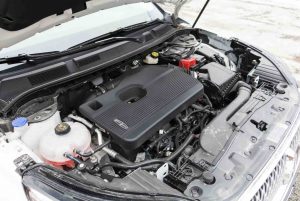
However, it cannot travel as far (on dry roads) as the hybrid Escape – which can go almost 40 miles on battery power alone.
The big question, of course, is whether the hybrid’s buy-in cost – about $12k above the asking price of the non-hybrid with AWD – will pencil out in gas savings over time.
Probably not – even with the available federal EV tax credit of almost $7k to sweeten the deal. Unless gas prices shoot up to $5 or more gallon.
Which is certainly possible.
But there are other ways it might pencil out, depending on how events play out. In the event gas becomes scarce, a vehicle you can plug in at home will keep you rolling; unless, of course, there are rolling blackouts – another possibility.
One can also foresee – because one can see this already, in Europe – areas where anything with a running gas engine is not allowed to roll. If such electric-only zones pop up here, owning a plug-in hybrid will also mean you can keep rolling.
So long as it is within range.
On the Road
The hybrid Corsair can’t go as far as its Ford-badged brother but it has considerably more potential electric-only range than hybrid versions of pricier luxury-brand small crossovers like the BMM X3 and Audi Q5 – which max out around 20 miles (or less).
Aber, as they say in the Fatherland – how far you can go on the batteries alone depends greatly on how fast and how hard you drive.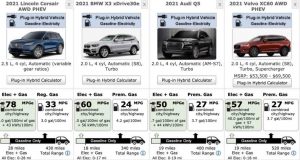
It takes power to move anything and more power to move it quickly – whether the source of power is hydrocarbons or kilowatts. If you accelerate gently, easing up to speed – and keep your speed closer to 55 than 75 – you may well get as far as the touted 28 miles before you run out of electric power. But if you need to go faster – or the road you’re on isn’t flat (or headed downhill) the distance you can travel before the gas engine kicks back on will probably be less.
Still, you can travel a respectable distance – and at viable road speeds – without the gas engine kicking on – which is what it’s all about when it comes to hybrids. And not having to plug the thing in is even more so. It is handy to be able to, of course. But – unlike a purely electric car – you have the option to not to, if it isn’t handy.
Though hybrids do cost more than their non-hybrid equivalents, they cost less than purely electric cars and they do not cost you anything in time or hassle – and that’s of value, too.
The non-hybrid versions of the Corsair are what they ought to be – as Lincolns rather than Fords. Meaning, they are as step up in terms of both refinement and power. It is a case of getting what you pay for. The Escape is a nice little crossover but its little 1.5 liter engine, though powerful for its size, isn’t as smooth or as quiet – probably a function of its odd-number of cylinders, which is probably not as balanced as a four’s even number of cylinders (with two going up while two go down).
The Corsair (and the Escape, to its credit) are also not afflicted with continuously variable (CVT) automatics, which are becoming a common as nits at Ellis Island back in the 1890s.
CVTs are being installed in new cars for no good reason; that bad reason being to squeeze out 2-3 MPG from the drivetrain, CVTs having a fuel-economy benefit over a conventional automatic that shifts through gears rather than strains through ranges, like a rubber band expanding and contracting. CVTs feel and sound like failing transmissions and almost no one likes them except the Compliance Officer stuck with the job of figuring out how to make new cars Uncle Friendly.
The Corsair is owner-friendly.
It doesn’t feel – or sound – like it has transmission trouble. It is also a Lincoln in fact as well as badge. If you drive one after driving an Escape you will feel (and not hear) the difference. The Lincoln rides softer and is so quiet – even without the hybrid drivetrain – that you wonder whether the engine is on.
Until it shuts off.
Every time you stop moving. That is automated stop/start “technology” – ASS – and you do feel – and hear – that. You also feel – and hear – the engine restarting. Over and over again.
This “technology” – afflicting almost all new cars (see the Compliance Officer) is there solely and only to accommodate Uncle, to the almost universal annoyance of drivers. Stop. Start. Stop. Start. Until you master the art of easing off the brake pedal just enough to confuse the sensors and keep the engine from shutting off.
Or you can shut the “technology” off, so as to keep the engine running. But a button is lacking. You must suss out the setting in the systems folder, within the apps – which can be a PITAS.
And so is ASS
At The Curb
The Corsair looks larger – longer – than it is, which is just 180.6 inches. This can be credited to the visual effect of its lower, more rakish roofline (vs. the Escape), which is about two inches down from the Ford’s. The downside of this is a bit less backseat headroom and total cargo capacity – 57.6 cubic feet vs. 65.4 cubic feet in the Ford.
Still, the Corsair is capable of getting eight-foot-long boards home, with the rear liftgate closed. Just drop (electrically) the second row seat backs and slide them down the center aisle. Use a floormat on the center console to keep from scuffing anything. Like the Escape, the Corsair is large enough on the inside to be a family’s primary vehicle – which a car with the same or even a much larger footprint on the outside isn’t.
The full-size Continental sedan had just 16.7 cubic feet of trunk, despite being 201.4 inches end to end (nearly two feet longer) than the Corsair.
Which explains why Lincoln – and so many other former car brands – no longer sell cars like the Connie, RIP.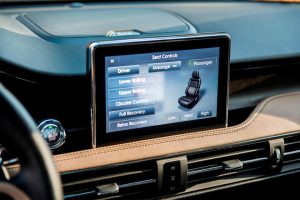
Crossovers and SUVs rule the roost.
In addition to more engine, the Corsair – being a Lincoln – also comes with and offers more amenities than you can get in the Escape, including that excellent 14 speaker Revel premium audio rig (a very good 10 speaker system is standard) as well as massaging seats for the driver and front seat passenger, a digital instrument cluster (Reserve trims) and a much larger (8 inch vs. 4.4 inch) secondary LCD touchscreen for the various apps, mounted on a stylish floating shelf that projects outward from the dashboard, making additional space for storage underneath.
Another thing this Lincoln comes with is an external keypad entry system mounted on the B pillar. If you forgot your key, you can still get in. You can also let someone else get in who hasn’t got a key.
Or, use your phone as your key. This Lincoln offers that option as well.
The Rest
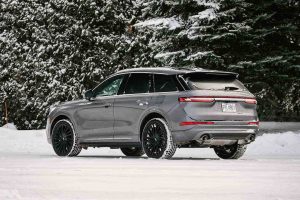 If you do some cross-shopping, you’ll discover that the non-hybrid version of the Corsair is a deal relative to what it would cost you to buy say a BMW X3, a Benz GLC or an Audi Q5 – all of which are similar in size/features/amenities and power.
If you do some cross-shopping, you’ll discover that the non-hybrid version of the Corsair is a deal relative to what it would cost you to buy say a BMW X3, a Benz GLC or an Audi Q5 – all of which are similar in size/features/amenities and power.
However, the hybrid Corsair is priced about the same as – or slightly higher than – the plug-in hybrid versions of the X3 ($49,600) and Q5 ($51,900).
But you can go about 10 miles farther on the batteries than they can.
Though not as far as the Ford can.
Unless it snows.
The Bottom Line
Lincoln isn’t selling cars anymore – but that doesn’t mean Lincolns aren’t selling. This Corsair being an example of why.
. . .
Got a question about cars, Libertarian politics – or anything else? Click on the “ask Eric” link and send ’em in!
If you like what you’ve found here please consider supporting EPautos.
We depend on you to keep the wheels turning!
Our donate button is here.
If you prefer not to use PayPal, our mailing address is:
EPautos
721 Hummingbird Lane SE
Copper Hill, VA 24079
PS: Get an EPautos magnet or sticker or coaster in return for a $20 or more one-time donation or a $10 or more monthly recurring donation. (Please be sure to tell us you want a magnet or sticker or coaster – and also, provide an address, so we know where to mail the thing!)
My eBook about car buying (new and used) is also available for your favorite price – free! Click here. If that fails, email me at EPeters952@yahoo.com and I will send you a copy directly!












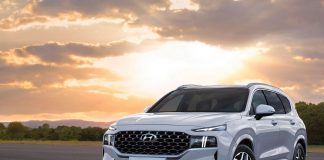
Lincolns have such buttoned-down, conservative styling. Silver paint only accentuates it.
The only plausible garb to wear in that vehicle would be a solid gray suit, white shirt, and matching solid gray tie.
That’s the way you plod along the beach in your black wingtips after parking the Lincoln, shedding the jacket and rakishly rolling your shirt sleeves halfway up.
Beach-goers make way, presuming you’re FBI rather than James Bond.
Sounds like this is what the Escape should be.
I also had no idea the Escape was a 3 banger now a days. Sad.
This hybrid thing – I just don’t know. I don’t see myself plugging a car in, so this extra weight & cost would be a waste for me.
So they’re down to 3 models now? It doesn’t sound like Ford has much planned except for some unprofitable eeeeelectric models few will buy. I guess Lincoln should be placed back on the list of dying brands.
I had no idea they were plunking 3 cylinder engines in cars as large as the escape. That’s disgusting.
I tried to get my Mom to buy this car, but she got the Q3 instead. She likes the Q3 but is very disappointed in the power, and why I recommended this Corsair. Ohh well, maybe next time.
Good review Eric, Thx.